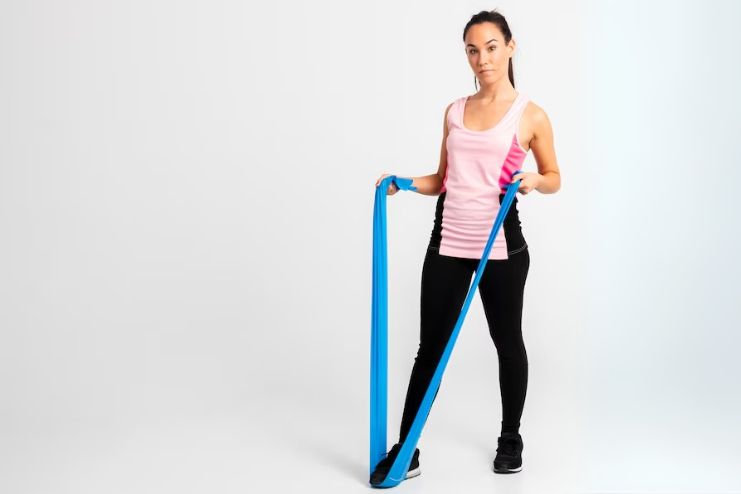Affiliate Disclaimer
Some links in this article are affiliate links. We may earn a small commission if you make a purchase through these links, at no extra cost to you. We only recommend products we find useful to our readersIf you’re looking to reduce body fat, build lean muscle, or enhance calorie burning, strength training is the ideal solution for your health and fitness goals, no matter your age.
As we age, we naturally lose lean muscle mass, which can lead to an increase in body fat percentage and make it challenging to maintain fitness. However, engaging in strength training allows you to preserve and build muscle at any age, helping you stay strong and healthy.
Incorporating variety into your strength training routine is equally important. Adding variety helps prevent plateaus, targets distinct muscle groups, keeps workouts fun, and prevents your body from becoming adapted to repetitive exercises.
If you want to add variety to your strength training routine, you must read ahead. Take your fitness a notch higher with battle ropes and resistance bands. Bonus point? You can use them anywhere. But, before concluding which equipment is best for full body strength, let us understand how each one of them works in detail.
Battle Ropes: The Power Tool

Battle ropes are thick ropes used for high-intensity workouts and calorie-burning exercises. One common misconception is that they are only used by elite athletes. In reality, battle ropes are a great way to assess your fitness level. Progressing by increasing the time or trying a different exercise with battle ropes is easy. The best part is that the rope’s weight is constant, making it easy to use.
Benefits of Battle Ropes: A Full-Body Workout
Battle ropes are ideal if you are looking for a full-body workout. They target most of the muscles in your body, including the abdomen, shoulders, lower and upper back, arms, and lower body.
- If you want to target a specific body part, you can easily change how you swing ropes.
- You can work on the external obliques by alternating your arms (unilateral waves).
- If you swing the ropes with both hands simultaneously, you can target the erector spinae muscles.
According to a study published on Pubmed, incorporating battle rope exercises three times a week can be a great way to improve core strength and stability. These exercises activate the core and challenge the abdominal muscles, lower back, and obliques.
As you move consistently, you improve your posture and functional fitness. Battle ropes are a good choice if you wish to blend cardiovascular benefits with core activation. Additionally, battle ropes are known to elevate the heart rate and enhance cardiovascular fitness. They improve aerobic activity and lead to improved endurance.
Limitations of Battle Ropes:
Though battle ropes are an effective way to strength train, they have limitations.
- Higher Impact: The movements can be explosive. While battle ropes help you with an intense workout, poor form can lead to significant injury risks. Improper alignment places undue stress on the shoulders, knees, and back. If you lift the ropes high, it strains the shoulder joints, and an improper squat position leads to knee injuries.
- Space and Anchor Need: Battle ropes require enough space and a strong anchor point, which can be challenging in small spaces.
- Quick Fatigue: Due to its high intensity, battle rope exercises may exhaust you quickly, making it difficult to carry out longer workouts.
- Monotony: You may feel a monotony kicking in if you do not try variations with battle ropes.
- Limited Lower Body Focus: Battle ropes are a perfect way to have an upper body workout, and they might not provide enough stimulation for the lower body..
- Proper Technique: You might encounter injuries if you do not follow a proper technique and have good guidance on battle rope workouts.
Resistance Bands: The Flexible Option
Resistance bands are elastic bands that strengthen muscles, improve flexibility, and burn energy. One of the best parts of using a resistance band is that it allows for a full range of motion and promotes muscle stability and balance. These bands suit individuals of all fitness levels, from beginners to sportspersons or athletes.

Key Strength Benefits of Resistance Bands:
- Variable Resistance:
- Resistance bands gradually increase tension as the band is stretched. This constantly challenges muscles throughout, making way for seamless muscle development
- Functional Movements:
- Resistance bands mimic natural movements like pushing, pulling, and squatting and train the muscles to work together in a coordinated fashion. This improves functional strength for daily tasks.
- Muscle Activation:
- The resistance bands provide constant tension, activating and stabilizing muscles that could have been neglected with traditional weight training. This improves overall stability and control.
- Accessibility and Versatility:
- Resistance bands are versatile. They are portable, less expensive, and can be used for a variety of exercises. They are perfect for all fitness levels and workout environments.
Limitations of using Resistance Bands:
- Resistance bands do not provide the same intensity for heavyweight lifters or advanced trainers. They are not sufficient to build significant muscle mass when compared to heavy weights
- Resistance bands can snap during use, which poses a risk of injury.
- Resistance bands do not have a fixed weight, so it is difficult to track the weight and intensity of training or workouts.
Now that we have understood the various aspects of both strength training tools, it’s a good time to compare them and understand their differences.
Battle Ropes v/s Resistance Bands: Which One is Better?
Here’s a comparison of battle ropes and resistance bands for strength and conditioning, backed by research and expert insights:
Strength and Muscle Building:
- Battle Ropes: As we have mentioned earlier, battle ropes engage multiple muscles at the same time. This dynamically improves endurance, enhances core stability, and boosts endurance. Their focus is on intensity and explosive power, making it a perfect choice for High-Intensity Interval Training (HIIT)
- Resistance Bands: Resistance bands provide controlled tension throughout your workout. Unlike battle ropes, they target one body part at a time. They increase strength and offer gradual resistance based on individual needs.
Space Requirements:
- Battle Ropes: Battle ropes essentially require a larger space and a secure anchor for the dynamic movements involved. A larger space not only ensures effective usage but also makes using battle ropes safer for high-intensity workouts
- Resistance Bands: Compared to battle ropes, resistance bands take much less space. They are perfect for compact spaces and do not need a fixed anchor point. Resistance bands are also a perfect choice for working out while on the go.
Versatility:
- Battle Ropes: Anchor needs space, hence, battle ropes are less versatile compared to resistance bands. One limitation is that the anchor needs limit their adaptability. Battle ropes are perfect for explosive as well as functional movements. This type of workout improves coordination, balance, and grip strength.
- Resistance Bands: Resistance bands are incredibly versatile. They are suitable for full-body workouts and can also target specific muscle groups. Resistance bands are an excellent choice for rehabilitation while adding variety to strength routines.
Suitability:
- Battle Ropes: Battle ropes are typically more challenging and better suited for individuals seeking high-intensity, full-body workouts. Despite being low-impact exercise, variations like slams can increase injury risks for beginners.
- Resistance Bands: Resistance bands are great for beginners and for people recovering from injuries. People who prefer low-impact strength training can choose resistance bands.
Tips for Combining Both for a Balanced Strength Program
If you want a controlled and targeted workout, opt for resistance bands. These bands improve stability and joint strength. Follow this with a high-intensity battle rope exercise to boost your endurance. This way, you can alternate between the two tools and add variety to your routine. You can also use them on separate days to avoid overtraining.
Final Thoughts: Do What Aligns with Your Goals
Both the tools, resistance bands, and battle ropes provide unique benefits. You must select the best tool depending on your goals. Other tool selection criteria can be space, preference, and fitness levels. All you can do is experiment with both to find which one aligns with your fitness goals. Together also, they provide various benefits to us. You choose what suits you!
In this Article




















